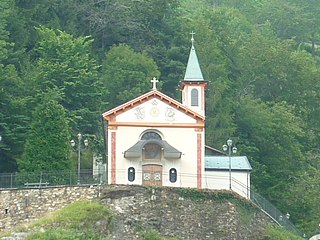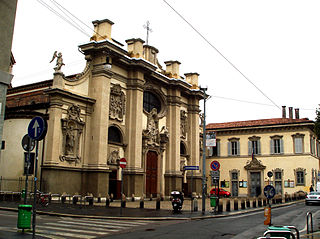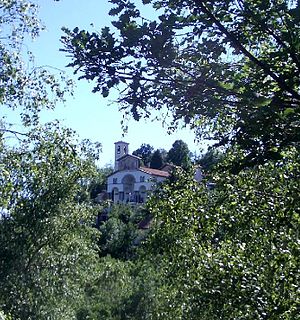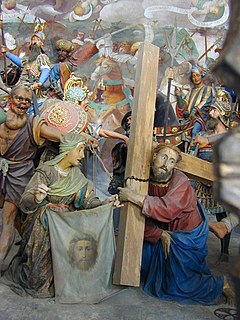Model and characteristics
The model of the calvary or "holy mountain" is a Christian creation dating from the late fifteenth century, that during the Counter-Reformation spread from Italy to Europe and the New World. A calvary is a devotional complex standing on the slopes of a mountain, with a series of chapels or kiosks containing scenes from the life of Christ, the Virgin Mary or the Saints, in the form of painting or sculptures.
As a re-evocation of the New Jerusalem, Sacred Mountains offered pilgrims an opportunity to visit the Holy Places by conjuring up, on a smaller scale, the buildings in which Christ's Passion took place. The Sacred Mountains stand on high ground, at some distance from the town centre, in a more natural setting. They are usually reached by pilgrimage. The itinerary leading up to the Sacred Mountain often re-evokes the Via Dolorosa, the road leading from Jerusalem to Calvary along which Christ carried the Cross.

Domodossola is a city and comune in the Province of Verbano-Cusio-Ossola, in the region of Piedmont, northern Italy. It was also known as Oscela, Oscella, Oscella dei Leponzi, Ossolo, Ossola Lepontiorum, and Domo d'Ossola.

Verbano-Cusio-Ossola is the northernmost province in the Italian region of Piedmont. It was created in 1992 through the fusion of three geographical areas which had previously been part of the Province of Novara. The area flanking the western shore of Verbano forms the eastern part of the province; Cusio and its environs form the southern part; while the north and west of the province consist of the Ossola, a region of Alpine mountains and valleys. The ISO code for the province is VB.
Varallo Sesia, pronouciation (Vhuh-rahl-loh) commonly known as Varallo, is a comune and town in the province of Vercelli in the Piedmont region of Italy. It is situated in Valsesia, at 450 metres (1,480 ft) above sea level and some 66 kilometres (41 mi) north-northeast of Vercelli and 55 kilometres (34 mi) northwest of Novara.

Ghiffa is a comune (municipality) in the Province of Verbano-Cusio-Ossola in the Italian region Piedmont, located about 120 kilometres (75 mi) northeast of Turin and about 7 kilometres (4 mi) northeast of Verbania on the western shore of the Lake Maggiore.

Valstrona is a comune (municipality) in the Province of Verbano-Cusio-Ossola in the Italian region Piedmont, located about 90 kilometres (56 mi) northeast of Turin and about 25 kilometres (16 mi) southwest of Verbania.

Pier Francesco Mazzucchelli was an Italian painter and draughtsman who was active in Milan. He is mainly known for his altarpieces, but his outstanding achievements are large decorative frescoes for the Sacro Monte di Varese and the Sacro Monte di Varallo.

Dionigi or Dionisio Bussola (1615–1687) was an Italian sculptor active mainly in Milan and its environs during the Baroque era.

Giuseppe Rusnati was a Lombard sculptor of the Rococo period. Known for having trained with Ercole Ferrata and subsequently from 1673 to c. 1686 training a young Camillo Rusconi, prior to the latter's relocation himself to Ferrata's studio in Rome. Born near Como; he died in 1713. He worked for many years for the Duomo of Milan, where he worked along with Giuseppe Buono (1670–1709/21) and Carlo Simonetta.

Antonio d'Enrico, called Tanzio da Varallo, or simply il Tanzio was an Italian painter of the late-Mannerist or early Baroque period.

The Sacred Mountain of Varallo is a Sacro Monte overlooking the town of Varallo Sesia in the province of Vercelli, Piedmont, northern Italy. It is the oldest Sacro Monte, founded in 1491 by Franciscan friar Bernardino Caimi. It is built on a natural terrace on the rocky slopes of Monte Tre Croci, on the left bank of the Sesia river where it leaves Val Mastallone. It is 600 m above sea level, 150 m above the historic centre of Varallo.

The Sacro Monte di Orta is a Roman Catholic devotional complex in the comune of Orta San Giulio on the summit of a hill known as San Nicolao, which faces the western shore of Lake Orta. It is one of the Sacri Monti of Piedmont and Lombardy, included in UNESCO World Heritage list.

The Sacred Mountain of Ghiffa is a Roman Catholic devotional complex in the comune of Ghiffa, Piedmont, northern Italy, overlooking the Lake Maggiore. It is one of the nine Sacri Monti of Piedmont and Lombardy, included in UNESCO World Heritage list.

The Sacred Mountain of Belmonte is a Roman Catholic devotional complex in the comune of Valperga, in the Metropolitan City of Turin. It is one of the nine Sacri Monti of Piedmont and Lombardy, included in UNESCO World Heritage list.

The Sacro Monte di Oropa is a Roman Catholic devotional complex in the province of Biella, Piedmont, northern Italy. It is one of the nine Sacri Monti of Piedmont and Lombardy and is on the UNESCO World Heritage list.

The Sacro Monte di Varese is one of the nine sacri monti in the Italian regions of Lombardy and Piedmont which were inscribed on the UNESCO list of World Heritage Sites in 2003. It has an altitude of 807 metres above sea level.

The Sacred Mount Calvary of Domodossola is a Roman Catholic sanctuary on the Mattarella Hill, overlooking Domodossola. It is one of the nine Sacri Monti of Piedmont and Lombardy, included in the UNESCO World Heritage list.

A calvary, also called calvary hill, Sacred Mount, or Sacred Mountain, is a type of Christian sacred place, built on the slopes of a hill, composed by a set of chapels, usually laid out in the form of a pilgrims' way. It is intended to represent the passion of Jesus Christ and takes its name after Calvary, the hill in Jerusalem where, according to tradition, Jesus was crucified.
CoEur is a Christian devotional and hiking route in Italy and Switzerland. Its Italian subtitle, Nel cuore dei cammini d'Europa, translates as "In the heart of Europe's paths".
The Path of Saint-Charles is an historical, artistic and devotional route which follows the travels of saint Charles Borromeo from Arona, his native town, and Viverone, where the path joins the Via Francigena.

The Church of Our Lady of the Graces is a Gothic-style, Roman Catholic temple in Varallo Sesia, province of Vercelli, region of Piedmont, Italy. The church was built, together with the adjacent Franciscan convent, by padre Bernardo Caimi between 1486 and 1493. At this time, the construction of the Sacro Monte was also beginning. In December 1931, Pope Pius XI gave the church the title of Minor Basilica.






















